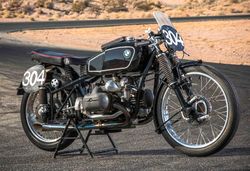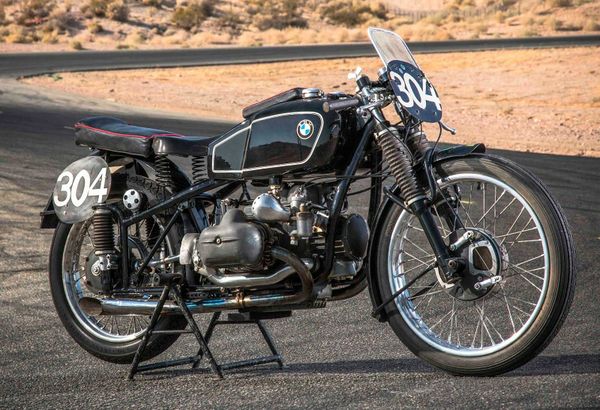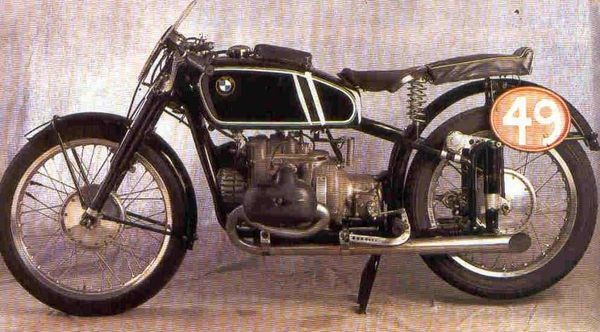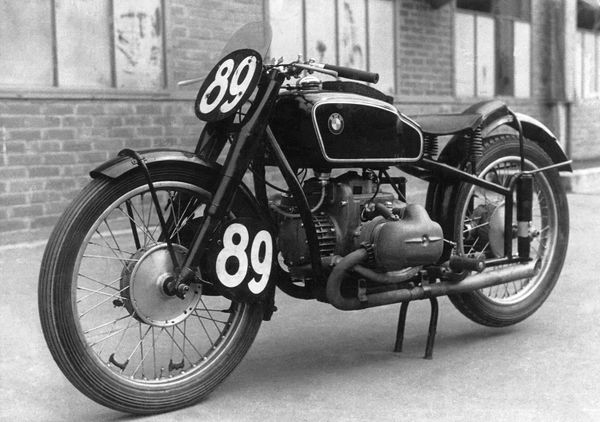BMW500 Supercharged
 |
|
| Racing Bikes BMW500 Supercharged | |
| Class | Racing |
|---|---|
| Weight | |
| Manuals | Service Manual |
Photos[edit | edit source]
Overview[edit | edit source]
BMW 500 Supercharged
BMW Type 255 Kompressor (also known as the 500 Kompressor, RS 255, RS255 and
Type 255 RS 500) was a supercharged boxer twin race motorcycle from the 1930s. A
BMW 255 Kompressor was ridden to victory by Georg Meier in the 1939 Isle of Man
TT and the first win by a non-British competitor in the premier 500cc Senior TT
class.
Overview
In 1938 the German BMW. challenge to Britain in
the Senior T.T. fizzled out, for one of the two German riders entered, K. Gall,
crashed whilst testing his machine before the race, and was unable to ride, and
Georg Meier had a machine that would only run on one pot; he discovered this
just after the start and retired at the foot of Bray Hill. J. M. "Jock" West
brought the Fatherland's third hope home in a very creditable fifth position,
just astern of the "works" Norton team and Stanley Woods on the big Velocette.
For 1939 the German factory made a determined
effort with the same team of riders. Poor Gall crashed and was killed on his
first practice lap, but Meier and West dominated the practice period. On race
day they dominated the race, with Meier a clear leader from start to finish52
sec. ahead on lap 1, 2 m. 20 s. at the endand, after tying for second berth
with Stanley Woods (Velocette) on lap 2, "J.M.W." pulled steadily away from the
field. Although the race average was a record, the 91 m.p.h. lap record (held by
Harold Daniell on a Norton), set up in 1938, was not broken as the two riders
were given the "slow" sign early in the race.
The BMW. machines were very similar to the racing
BMW.s seen today, except that a supercharger was used, driven from the front end
of the crankshaft and feeding each of the flat-twin's cylinders by a pipe under
the barrel. Shaft drive and telescopic-forks were standard plus plunger rear
springing with hydraulic damping and coil springs. Both hubs were "full-width"
type. Valve operation was by overhead camshaft, but otherwise the machines
looked strikingly like the sports roadsters made by the factoryand re-made
after the war.
The factory managed successfully to adapt its
racer to run without a "blower", but the post-war model never found any favor
in solo races in the Island, despite some spirited riding by Walter Zeller in
the fifties. However, it has proved almost invincible in sidecar classes.
SPECIFICATION
Engine: flat-twin 500 c.c. o.h.c; supercharger carried on forward extension of
camshaft; shaft and bevel drive to camshafts.
Ignition: magneto.
Transmission: shaft and bevel via four-speed gearbox
in unit with engines. Frame: duplex cradle with plunger rear suspension. Forks:
telescopic.
BMW 500 Story Until 1935 the BMW racing department concentrated its energy and talent on setting world speed records for two-wheelers. It is true that as early as 1925 BMW models that had been derived from production versions were entered in speed races. The first one to be entered was the BMW 500 R 37, with side-valve distribution. Subsequently head valves were introduced and finally a supercharger was added, which accounted for many of BMW's speed records. In 1935 BMW finished tuning a new 500-cc. Grand Prix motorcycle. The only part of its design that was closely modeled on the production version was the arrangement of the cylinders. They were horizontally opposed at 180°. Its distribution was the single-shaft type, but doubled. This amounted to two camshafts set close to each other. The two shafts worked together and operated the valves by means of rockers. With Zoller's supercharger, the BMW Grand Prix engine could generate more than 80 h.p. at 8,000 r.p.m. After a year of preparation the BMW two-cylinder started to show up frequently on the main European tracks. The motorcycle overcame various problems and soon proved to be a winner, thanks chiefly to the efforts of such skilled racers as K. Gall, Jock West, and Georg Meier. In 1937 the BMW 500 began to make a name for itself, and in 1938 it took the world championship. At the Italian Grand Prix at Monza the BMW outdid all its rivals. The Monza track is a fast one, perfect for showing off an engine's power. That same year the BMW was entered at the Tourist Trophy on the Isle of Man, but Gall had an accident during the trials, and Meier and West were both forced to withdraw because of breakdowns. The BMW was entered at the Tourist Trophy again in 1939 with the same teamwith fatal results for Gall, who was killed in an accident during the first trial lap. Meier and West were more fortunate than Gall, chalking up the two best qualifying times. On the day of the race Meier started out in first place and held it until the end. His teammate West had to fight off Stanley Woods and his Velocette on the second lap and then held second place until the end of the race. Despite this sensational victory, the BMW with supercharger lost the European championship to the rising Gilera four-cylinder motorcycle, ridden by Dorino Serafini. The BMW had as much power as the Italian motorcycle, but it was disadvantaged by stability problems that were not solved in time. Motorcycle: BMW 500 with Superch?rger Manufacturer: BMW, Munich Type: Racing Year: 1939 Engine: BMW two-cylinder, opposed at 180°. Four-stroke. Double single-shaft overhead distribution. Supercharger. Displacement 492.6 cc. (66 mm. x 72 mm.) Cooling: Air Transmission: Four-speed block. Final transmission, cardanic shaft Power: Over 80 h.p. at 8,000 r.p.m. Maximum speed: 140 m.p.h. Chassis: Continuous double cradle with tubular elements. Front and rear, elastic suspension Brakes: Front and rear, central drum


